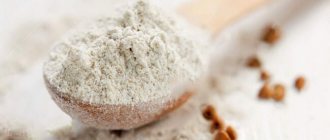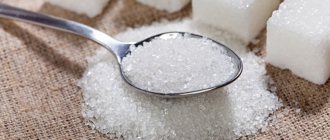Almond flour
- Potassium 659 mg
- Calcium 236 mg
- Magnesium 268 mg
- Sodium 19 mg
Almonds are highly valued all over the world. It is consumed in its pure form as a snack, added to baked goods, salads, and butter and flour are also obtained from it. The benefits of almonds have been praised many times, but what about the flour obtained from them? Fortunately, this product retains almost all the beneficial qualities of the nut. The main advantage of almond flour is the absence of gluten. Therefore, it is good to use for those who are allergic to gluten or follow a diet for other medical reasons. Almond flour has replaced wheat flour for many. And no wonder.
Composition of almond flour
The composition of almond flour purchased in a store or prepared at home will be almost identical. But if you don’t trust factory products and want to make almond flour at home, you can do it without difficulty. You will find a recipe for almond flour at home below in the article. Per 100 grams of almond flour there are 13 grams of carbohydrates, 25 grams of protein and 54 grams of fat. Seeing this ratio, you may be surprised, because, for example, in the white flour we are used to, there is practically no fat and protein. But do not forget that almond flour is made from the nut itself, which is rich in these components.
At the same time, the calorie content of almond flour is 602 kcal per 100 grams, which, of course, is more than the calorie content of wheat flour. However, don't be scared. After all, the benefits of a product are more important than its energy value. Therefore, moderate consumption of almond flour products will only bring beneficial effects to your body. Almonds also contain a lot of omega-3 fatty acids. Almost 20% of these total fats are recommended for daily consumption, and only 1% is saturated fat. At the same time, there is no cholesterol in almonds and almond flour. It is also important that per 100 grams of almond flour there are only 2.5 grams of sugar. This means the product is safe for diabetics.
Almonds are rich in various beneficial minerals, especially magnesium. Just imagine, 100 grams of almond flour contains as much as 160 milligrams of calcium and magnesium, 325 milligrams of phosphorus. There is manganese and zinc in small quantities. Almonds are rich in vitamin E, which is contained in almond flour in the amount of 6.35 mg. Flour also contains other vitamins such as , (niacin), (riboflavin) and (thiamine). Almond flour contains 0.8 g of ash and 1.3 g of water. Such a rich and varied composition of almond flour makes it an attractive product for adherents of a healthy lifestyle and gourmets.
Where is it used?
Used in many industries. Added to bread, pasta, cookies, breakfast cereals, sausages and processed foods.
Adding it to various baked goods allows you to maintain the volume of the product and make it more tender. At the same time, the dough becomes plastic and easier to roll out. Bakery and confectionery products with the addition of powder do not go stale longer. During production, they do not absorb a lot of fat (for example, donuts, crumpets).
When baking, it can easily replace eggs . Instead of one egg, take a tablespoon of flour diluted in a tablespoon of water. Used as a thickener for various sauces. Addition to various products enriches them with vitamins and increases nutritional value. Reduces its cost.
Soy is added not only to bread and confectionery products. It is also found in vegetable purees, canned fish and meat. Soy is added in small quantities, only from one to five percent.
Soy protein is also used in cosmetology. Skin and hair care products are made on its basis. Soy cosmetics smooth out wrinkles and moisturize the skin.
Manufacturing technology for almond flour
When producing almond flour, the factory uses the following technology. First of all, almonds are cleaned of debris and separated into separate fractions. They are then steamed and peeled. At the same time, at the next stage of the production line, quality control of peeling almond nuts is provided. Incompletely peeled nuts are sent for re-cleaning.
After cleaning, the almonds undergo two-stage drying, which removes moisture both from the surface of the nuts and from the inside. Then, using special equipment, the nuts are crushed, crushed and finely ground. Modern equipment allows you to adjust the size of the fraction and achieve grinding up to 40 microns. The resulting powder is distributed into batches and sent to prepared packages.
Cooking at home
You can create your own almond mixture at home:
- Take the almonds and rinse them well under running water, then place them in a deep plate and cover with boiled water. Leave the ingredients in this form for ten minutes.
- After the required time has passed, the water is drained and the peel is removed from the almonds.
- You need to use dry nuts when cooking, so be sure to dry them well before starting.
You can dry almonds using napkins or using the oven. To do this, you need to heat it to the desired temperature and continue to hold it until it dries completely.- Now you need to use a coffee grinder or blender.
- After this, the resulting mass must be sifted through a sieve, and everything that remains in it must be ground a second time using a coffee grinder. After this, the consistency is sifted again and so on until after sifting there are no more large particles of nut remaining.
- The resulting mixture should be spread out on paper to allow it to dry thoroughly, then put into a bag or plastic container and put in a dark place for later storage.
Almond flour prepared at home will not be exactly the same as store-bought flour, since production most often uses special equipment that quickly and efficiently grinds almonds. At the same time, flour made with your own hands will be more useful than that which many people buy in the store. This flour can be stored for one to three months in a dark and cool place.
There are no products that can replace almond flour in baking. But you can try using peanut flour or ground seeds.
Product varieties
The food industry offers only 3 variations of soy flour: low-fat, non-fat, semi-skimmed.
The low-fat product is made from food meal.
Meal is a by-product of oil production. Fat is extracted from seeds/beans using organic solvents. The resulting product is a valuable nutritious food product. Meal is especially valued for its high protein concentration. The component is used both as an additive to the human diet and as a high-protein feed for animals.
To create full-fat flour, peeled, hulled and deodorized beans are used. The semi-skimmed product consists of soybean cake that has been pre-fat separated and pressed.
According to the variety criteria, soy flour is no different from any other. The first and highest grades indicate additional processing of soybeans. This flour contains absolutely no fiber, vitamins or beneficial nutrients. The processing independently adjusts the composition and instead of a valuable food product, we get empty calories. Always choose wholemeal flour to ensure that your meal is not only tasty, but also nutritious.
Corn
Many believe that the healthiest flour not only for weight loss, but also for health in general is corn flour. And this opinion is not unfounded. It, like buckwheat, does not contain gluten, but is rich in vitamins A, E, group B and many microelements (iron, potassium, phosphorus, calcium, magnesium, etc.).
Distinctive features:
- There are three varieties: fine and coarse grinding, wallpaper;
- yellow or white;
- sweetish taste;
- meadow smell;
- Baking from it does not have any fluffiness.
Secrets of use: for the dishes to be successful, you must add oil. Considering the process of losing weight, it is better to give preference to olive, but not creamy. Can be mixed with wheat and rye.
When preparing what dietary dishes can you use:
- flatbreads;
- casserole;
- syrniki.
For a long time, corn flour was treated with prejudice (it is inexpensive, accessible mainly to the poor, and the baked goods are not as fluffy as we would like). But time put everything in its place. This product improves digestion, promotes the flow of bile and normalizes the functioning of the heart and blood vessels.
However, those who use glycemic diets for weight loss should take into account the high GI of this product.
Calorie content Soy flour. Chemical composition and nutritional value.
Nutritional value and chemical composition of “Soy flour”.
The table shows the nutritional content (calories, proteins, fats, carbohydrates, vitamins and minerals) per 100 grams of edible portion.
| Nutrient | Quantity | Norm** | % of the norm in 100 g | % of the norm in 100 kcal | 100% normal |
| Calorie content | 274 kcal | 1684 kcal | 16.3% | 5.9% | 615 g |
| Squirrels | 40 g | 76 g | 52.6% | 19.2% | 190 g |
| Fats | 1.5 g | 56 g | 2.7% | 1% | 3733 g |
| Carbohydrates | 23 g | 219 g | 10.5% | 3.8% | 952 g |
| Alimentary fiber | 17.5 g | 20 g | 87.5% | 31.9% | 114 g |
| Water | 7.25 g | 2273 g | 0.3% | 0.1% | 31352 g |
| Ash | 6.15 g | ~ | |||
| Vitamins | |||||
| Vitamin A, RE | 2 mcg | 900 mcg | 0.2% | 0.1% | 45000 g |
| beta carotene | 0.024 mg | 5 mg | 0.5% | 0.2% | 20833 g |
| Vitamin B1, thiamine | 0.698 mg | 1.5 mg | 46.5% | 17% | 215 g |
| Vitamin B2, riboflavin | 0.253 mg | 1.8 mg | 14.1% | 5.1% | 711 g |
| Vitamin B4, choline | 11.3 mg | 500 mg | 2.3% | 0.8% | 4425 g |
| Vitamin B5, pantothenic | 1.995 mg | 5 mg | 39.9% | 14.6% | 251 g |
| Vitamin B6, pyridoxine | 0.574 mg | 2 mg | 28.7% | 10.5% | 348 g |
| Vitamin B9, folates | 305 mcg | 400 mcg | 76.3% | 27.8% | 131 g |
| Vitamin E, alpha tocopherol, TE | 0.12 mg | 15 mg | 0.8% | 0.3% | 12500 g |
| Vitamin K, phylloquinone | 4.1 mcg | 120 mcg | 3.4% | 1.2% | 2927 g |
| Vitamin RR, NE | 2.612 mg | 20 mg | 13.1% | 4.8% | 766 g |
| Macronutrients | |||||
| Potassium, K | 2384 mg | 2500 mg | 95.4% | 34.8% | 105 g |
| Calcium, Ca | 241 mg | 1000 mg | 24.1% | 8.8% | 415 g |
| Magnesium, Mg | 290 mg | 400 mg | 72.5% | 26.5% | 138 g |
| Sodium, Na | 20 mg | 1300 mg | 1.5% | 0.5% | 6500 g |
| Phosphorus, Ph | 674 mg | 800 mg | 84.3% | 30.8% | 119 g |
| Microelements | |||||
| Iron, Fe | 9.24 mg | 18 mg | 51.3% | 18.7% | 195 g |
| Manganese, Mn | 3.018 mg | 2 mg | 150.9% | 55.1% | 66 g |
| Copper, Cu | 4065 mcg | 1000 mcg | 406.5% | 148.4% | 25 g |
| Selenium, Se | 1.7 mcg | 55 mcg | 3.1% | 1.1% | 3235 g |
| Zinc, Zn | 2.46 mg | 12 mg | 20.5% | 7.5% | 488 g |
| Digestible carbohydrates | |||||
| Mono- and disaccharides (sugars) | 16.42 g | max 100 g | |||
| Essential amino acids | |||||
| Arginine* | 3.647 g | ~ | |||
| Valin | 2.346 g | ~ | |||
| Histidine* | 1.268 g | ~ | |||
| Isoleucine | 2.281 g | ~ | |||
| Leucine | 3.828 g | ~ | |||
| Lysine | 3.129 g | ~ | |||
| Methionine | 0.634 g | ~ | |||
| Threonine | 2.042 g | ~ | |||
| Tryptophan | 0.683 g | ~ | |||
| Phenylalanine | 2.453 g | ~ | |||
| Nonessential amino acids | |||||
| Alanin | 2.215 g | ~ | |||
| Aspartic acid | 5.911 g | ~ | |||
| Glycine | 2.174 g | ~ | |||
| Glutamic acid | 9.106 g | ~ | |||
| Proline | 2.75 g | ~ | |||
| Serin | 2.725 g | ~ | |||
| Tyrosine | 1.778 g | ~ | |||
| Cysteine | 0.757 g | ~ | |||
| Saturated fatty acids | |||||
| Saturated fatty acids | 0.136 g | max 18.7 g | |||
| 14:0 Miristinovaya | 0.003 g | ~ | |||
| 16:0 Palmitinaya | 0.1 g | ~ | |||
| 18:0 Stearic | 0.034 g | ~ | |||
| Monounsaturated fatty acids | 0.208 g | min 16.8 g | 1.2% | 0.4% | |
| 16:1 Palmitoleic | 0.003 g | ~ | |||
| 18:1 Oleic (omega-9) | 0.206 g | ~ | |||
| Polyunsaturated fatty acids | 0.533 g | from 11.2 to 20.6 g | 4.8% | 1.8% | |
| 18:2 Linolevaya | 0.47 g | ~ | |||
| 18:3 Linolenic | 0.063 g | ~ | |||
| Omega-3 fatty acids | 0.063 g | from 0.9 to 3.7 g | 7% | 2.6% | |
| Omega-6 fatty acids | 0.47 g | from 4.7 to 16.8 g | 10% | 3.6% |
The energy value of soy flour is 274 kcal.
Primary Source: Created in the application by the user. Read more.
** This table shows the average levels of vitamins and minerals for an adult. If you want to know the norms taking into account your gender, age and other factors, then use the “My Healthy Diet” application.
Benefits of almond flour
Almond flour retains all the beneficial qualities of almonds, which makes it incredibly healthy. Almond flour is most useful because it contains large quantities of vitamin E, which is an antioxidant. It not only cleanses the body of toxic substances, but also prolongs the life of cells and the body, and also reduces the risk of developing various diseases.
Eating almond flour improves the condition of the nervous system and relieves tension. This effect is provided by vitamin B contained in almonds. The minerals found in almond flour normalize the functioning of the heart, kidneys and liver. Thanks to a large number of useful vitamins and macro- and microelements, almond powder improves human immunity, protecting it from viruses and bacteria.
Low-fat almond flour
The high fat content is undesirable in many types of nutrition, but for the ketogenic diet it has become an obvious advantage. This is why almond flour is a popular base for many types of dishes here. Most cooks use its classic version.
A low-fat product differs from it in the way the raw materials are processed. The nuts are cleaned and then cold pressed. Low-fat almond flour can be used to prepare low-calorie dishes. It has no other significant advantages.
According to the American Heart Association, consuming just 1 serving of almonds per day can meet 5% of your body's potassium needs. This substance is directly related to heart health. A sufficient amount of potassium helps normalize blood pressure. Other studies published in the Archives of Internal Medicine confirm that adequate intake of potassium, including almond flour, helps reduce the overall risk of developing cardiovascular disease by 37%.[3][4]
Diet cookies
Recipes for dietary baking made from soy flour include not only pancakes. If you need a composition that contains more protein and less carbohydrates, then you should perform the following variation.
Ingredients:
- 100 g soy flour;
- 2 times more apples;
- 2 squirrels;
- 20 g oatmeal;
- 10 ml olive oil;
- a little sweetener and soda.
Sequencing:
- The fruits are cleaned, de-seeded and grated.
- The grated mass is mixed with proteins and a sugar substitute;
- After adding the oil, add flour, ground flakes and soda.
- A homogeneous dough is kneaded, from which flat cakes are formed.
- The products are laid out on a baking sheet, which is placed in a hot oven (180 °C) for 25 minutes.
Before placing the mold in the oven, the products are pierced with a fork.
Main characteristics
The main characteristics of flour are as follows:
- Ground almonds contain a large number of medicinal healing properties.
- Using this flour, the consistency of many dishes can be made thicker.
- Flour gives cooked food a more pronounced smell and taste.
- Products from such a mixture can be prepared quickly, since the nut powder itself is considered a finished product.
- Baking with almonds will never turn out too dry, thanks to the property of almonds to retain liquid.
- Does not contain gluten, a substance that causes allergic reactions in some people.
Calorie content
Almond flour has a calorie content of 602 kcal per 100 g of product . They contain:
- proteins - 25.86 g, which equals 103 kcal;
- fats - 54.55 g, which reaches 491 kcal;
- carbohydrates - 3.02 g, which is 12 kcal.
Harm of almond flour
There can be no direct harm from almond flour. However, if consumed excessively, flour can cause stagnation in the gastrointestinal tract. For better absorption and digestion of almond flour, it is recommended to consume it with honey and sugar.
People with heart problems should consult a specialist before consuming almond flour. A high content of essential oils may affect the operation of this system. In addition, the calorie content of almond flour is considerable. Therefore, it should be consumed very carefully and in moderation to avoid gaining excess weight.
The benefits and harms of almond flour
Healthy nutrition experts classify almond flour as a healthy food. It is believed to be rich in nutrients, vitamins and microelements. Moreover, due to the good ratio of proteins, fats and carbohydrates, it can be equally used for weight loss and weight gain.
If we touch on the topic of the benefits and harms of flour, I will highlight several points that may be important for your loved ones and clients:
- No gluten. Nuts are naturally gluten-free. Therefore, you don’t have to worry about allergies.
- No cholesterol. Despite the high fat content, almonds are safe for the heart and blood vessels.
- Lots of useful substances. 100 g of flour contains the daily requirement of vitamin E, silicon, cobalt and manganese. About 30% of the daily intake of vitamins B2, PP, biotin, potassium, calcium, phosphorus.
With many beneficial properties, the only possible harm is individual intolerance to almonds. Otherwise, the flour is completely safe. The main thing is not to overeat delicious baked goods.
Almond flour is a popular confectionery ingredient.
The content of the article
Almond flour is an excellent substitute for regular flour and is lower in carbohydrates. Competes with traditional flour in its ability to produce soft and fluffy baked goods.
This flour is obtained from peeled almonds - after the kernel shell is removed, the nuts are crushed.
What is almond flour
Almond flour is made from almond kernels. They are ground to a powder state. In this form, the product can well be used instead of classic wheat flour, even if it is a rather expensive alternative. But you will immediately feel that the result will differ not only in price, thanks to:
- denser and greasy texture;
- sweetish taste;
- characteristic nutty aroma.
If you replace wheat flour with almond flour, the baked goods will be sweeter, more crumbly and tender. But if desired, a similar effect can be achieved using other types of nut flour.
Can it be replaced?
Unfortunately, it is not possible to replace this ingredient in any recipe with regular flour. And by using some kind of crushed nut, instead of an almond delicacy, you can also get something tasty, but the name of this culinary masterpiece will be different.
Having learned from the article about the composition of almond flour, novice cooks should understand that it is best to prepare this product shortly before using it in baking. This means that it is necessary to take care of the safety of the grains . And those, in turn, are better stored in the shell.
How to properly store almond flour
Almond flour's worst enemy is high humidity. If it exceeds 60%, this can lead to several adverse consequences at once:
- Lumps. When the moisture content is high, the nut flour particles stick together. They, of course, can be dried and ground through a sieve. But it's still unpleasant.
- Mold. This is a ubiquitous problem with any natural ingredients. If the flour is not ventilated and gets wet, the spores will germinate easily. If you find fungus, it is better to throw out the entire supply of almonds. It is guaranteed to be hazardous to health.
- Bitter taste. The combination of moisture and elevated temperature causes the almond butter remaining in the flour to deteriorate. It’s impossible to make delicious desserts with this ingredient.
Therefore, it is better to store small amounts of flour on a shelf in a cool, dry place rather than in the refrigerator. This way you will avoid condensation.
There is another problem. Nuts are very fond of small bugs and other pests. Therefore, it is advisable to store flour in a closed container. In addition, it absorbs odors very easily and the packaging must be sealed. At the same time, this will help preserve beneficial essential oils.
As a result, the best conditions for storing almond flour are:
- sealed plastic or glass container;
- temperature up to +25°C;
- humidity not higher than 60%.
The shelf life of flour is 1 year in original packaging. For opened - 2 months. To maximize shelf life, it is better to transfer large volumes of flour to the refrigerator or even freezer. But in this case, before work, each portion must be dried separately for 10 minutes at 150°C in the oven. This will help get rid of excess moisture that appears from condensation due to temperature changes.
What is grinding?
Flour, obtained from the same raw material, but using different processing methods, differs in its grinding:
- Fine grinding - such a product is the result of cleansing the grain from the shell, bran and aleurone layer. It is quickly digestible due to the significant amount of carbohydrates in the composition.
- Medium grind – this type of flour contains fiber from the grain shell. Use is limited.
- Coarse Grind (Whole Wheat Flour) – Similar to ground grain. The product has all the components of the original raw materials. It is most suitable and useful for use with diabetes and a healthy diet.
Approximate composition of flour:
- starch (from 50 to 90% depending on the variety);
- proteins (from 14 to 45%) – wheat has low levels, soybeans have the highest;
- lipids – up to 4%;
- fiber – dietary fiber;
- B-series vitamins;
- retinol;
- tocopherol;
- enzymes;
- minerals.
Properties of almond flour
Almond-based powder has a number of properties that are not inherent in ordinary flour. For example:
- does not contain cholesterol, which has a positive effect on the condition of people with diseases of the cardiovascular system;
- contains a small amount of fat, as a result of which even people on a diet can use it when preparing dishes;
- does not contain a large amount of sugar.
However, like every product, such a powder has beneficial and harmful qualities.
Benefits of almond flour
- The benefits of stone-based flour are as follows:
- it contains a small amount of sugar. Thanks to this property, it becomes useful for people with group I and II diabetes. However, the important point is that the wheat variety does not contain sugar at all, so it can also be used in the presence of such a disease;
- this powder contains a large amount of vitamins that help strengthen hair and bones;
- the product does not contain a large amount of carbohydrates, which is useful for people on a diet;
- dishes prepared with this product have a positive effect on the human digestive system and also help remove toxins from the body.
Thus, we can conclude that this variety has significant advantages and a large number of advantages. What are the disadvantages of this product? It is important not to overdo it in its use in order not to gain excess weight.
Harm and contraindications
Dishes based on almond flour can be consumed by all people, with the exception of those who have individual intolerance. If you have an allergic reaction, you should not eat this product. People on strict diets should also limit their consumption. In other cases, there are no restrictions on the use of the product.
Important! Almond flour will be an excellent alternative to wheat flour, as it has fewer calories.











